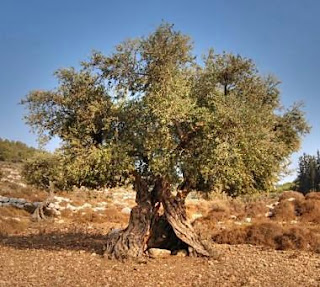 |
| Ancient olive tree |
Olives were a natural resource in the Near East 6,000 years ago. Ancient documents mention an olive tree in Heliopolis (Biblical On) during V Dynasty (BC 2494 to 2345). Trade records from the IV Dynasty (BC 2613 to 2494) list olive oil among the goods traded from Syria and Canaan. The olive tree appears in the hieroglyphs, drawings, and statues of high ranking Egyptians, and objects made of olive wood were found in Tutankhamun's tomb.
Olive trees grew in the region of Lake Chad during the time Noah lived there (BC 2490-2415). Genesis 8:11 recounts how a dove returned to Noah’s ark carrying an olive branch in its beak. Both the olive branch and the dove are symbols of peace. Olive trees grew in the Hoggar and Air mountains and along a 750-mile plain leading south to Lake Chad.
Production and uses of olive oil
Olive oil was used for lamp fuel, medicinal ointment, making soap, skin moisturizer, perfumes, cooking oil, and as a food. Olive oil was used in offerings to God. Leviticus 8:26 speaks of offerings of bread cakes anointed with oil.
Olive oil was used to anoint rulers, priests, and warriors. God said to Samuel, “Fill your horn with oil, and go; I am sending you to Jesse, the Bethlehemite. For I have provided Myself a king among his sons” (I Sam.16:1). When David was presented before Samuel, the prophet “took the horn of oil, and anointed him in the midst of his brothers; and the Spirit of the LORD came upon David from that day forward” (I Sam.16:13). God said, “I have found My servant David; with My holy oil, I have anointed him” (Psalm 89:20).
The word "messiah" means "the anointed one" and the substance used for anointing was olive oil. The Hebrew word for “olive tree” is es shemen, which means ‘tree of oil.” It is from the root meaning “to shine” and is related to shemesh, the Hebrew word for the sun.
 |
| A donkey turns the stone that presses the olives. |
To make oil the olives were mashed in a mortar, crushed in a press, or stomped under foot the way grapes are crushed to get the juice. Ancient stone presses have been found throughout the Near East, Israel, and the Arabian Peninsula. The circular grinding stones, like the circular threshing floors, reminded people of the Most High God, whose emblem was the sun.
The Encyclopedia Judaica gives this explanation of the process of oil production:
“The olives were beaten down from the trees with poles (Isa.17:6), and were pounded into pulp in mortars or by the feet (Micah 6:15). The pulp was placed in wicker baskets from which the lightest and finest oil could easily run off This grade of oil, known as beaten oil (Heb. Shenen katit), is mentioned five times in the Bible. It served as fuel for the lamp in the Tabernacle (Ex.27:20; Lev.24:2) and as an element in the obligatory daily meal offerings (Ex.29:40; Num.28:5). King Solomon traded this type of oil with Hiram of Tyre in exchange for cedar and cypress wood (I Kings 5:10-11). After the removal of the beaten oil, a second grade was produced by heating and further pressing the pulp. . ."
The oil was then stored in wooden vats or stone jars.
Related reading: Images of Near Eastern Oil Presses; Threshing Floors and Solar Symbolism

No comments:
Post a Comment